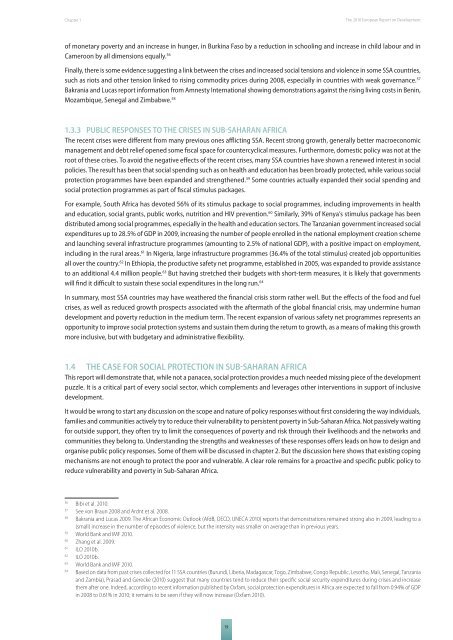social protection for inclusive development - European Report on ...
social protection for inclusive development - European Report on ...
social protection for inclusive development - European Report on ...
Create successful ePaper yourself
Turn your PDF publications into a flip-book with our unique Google optimized e-Paper software.
Chapter 1<br />
The 2010 <str<strong>on</strong>g>European</str<strong>on</strong>g> <str<strong>on</strong>g>Report</str<strong>on</strong>g> <strong>on</strong> Development<br />
of m<strong>on</strong>etary poverty and an increase in hunger, in Burkina Faso by a reducti<strong>on</strong> in schooling and increase in child labour and in<br />
Camero<strong>on</strong> by all dimensi<strong>on</strong>s equally. 56<br />
Finally, there is some evidence suggesting a link between the crises and increased <str<strong>on</strong>g>social</str<strong>on</strong>g> tensi<strong>on</strong>s and violence in some SSA countries,<br />
such as riots and other tensi<strong>on</strong> linked to rising commodity prices during 2008, especially in countries with weak governance. 57<br />
Bakrania and Lucas report in<str<strong>on</strong>g>for</str<strong>on</strong>g>mati<strong>on</strong> from Amnesty Internati<strong>on</strong>al showing dem<strong>on</strong>strati<strong>on</strong>s against the rising living costs in Benin,<br />
Mozambique, Senegal and Zimbabwe. 58<br />
1.3.3 PUBLIC RESPONSES TO THE CRISES IN SUB-SAHARAN AFRICA<br />
The recent crises were different from many previous <strong>on</strong>es afflicting SSA. Recent str<strong>on</strong>g growth, generally better macroec<strong>on</strong>omic<br />
management and debt relief opened some fiscal space <str<strong>on</strong>g>for</str<strong>on</strong>g> countercyclical measures. Furthermore, domestic policy was not at the<br />
root of these crises. To avoid the negative effects of the recent crises, many SSA countries have shown a renewed interest in <str<strong>on</strong>g>social</str<strong>on</strong>g><br />
policies. The result has been that <str<strong>on</strong>g>social</str<strong>on</strong>g> spending such as <strong>on</strong> health and educati<strong>on</strong> has been broadly protected, while various <str<strong>on</strong>g>social</str<strong>on</strong>g><br />
<str<strong>on</strong>g>protecti<strong>on</strong></str<strong>on</strong>g> programmes have been expanded and strengthened. 59 Some countries actually expanded their <str<strong>on</strong>g>social</str<strong>on</strong>g> spending and<br />
<str<strong>on</strong>g>social</str<strong>on</strong>g> <str<strong>on</strong>g>protecti<strong>on</strong></str<strong>on</strong>g> programmes as part of fiscal stimulus packages.<br />
For example, South Africa has devoted 56% of its stimulus package to <str<strong>on</strong>g>social</str<strong>on</strong>g> programmes, including improvements in health<br />
and educati<strong>on</strong>, <str<strong>on</strong>g>social</str<strong>on</strong>g> grants, public works, nutriti<strong>on</strong> and HIV preventi<strong>on</strong>. 60 Similarly, 39% of Kenya’s stimulus package has been<br />
distributed am<strong>on</strong>g <str<strong>on</strong>g>social</str<strong>on</strong>g> programmes, especially in the health and educati<strong>on</strong> sectors. The Tanzanian government increased <str<strong>on</strong>g>social</str<strong>on</strong>g><br />
expenditures up to 28.5% of GDP in 2009, increasing the number of people enrolled in the nati<strong>on</strong>al employment creati<strong>on</strong> scheme<br />
and launching several infrastructure programmes (amounting to 2.5% of nati<strong>on</strong>al GDP), with a positive impact <strong>on</strong> employment,<br />
including in the rural areas. 61 In Nigeria, large infrastructure programmes (36.4% of the total stimulus) created job opportunities<br />
all over the country. 62 In Ethiopia, the productive safety net programme, established in 2005, was expanded to provide assistance<br />
to an additi<strong>on</strong>al 4.4 milli<strong>on</strong> people. 63 But having stretched their budgets with short-term measures, it is likely that governments<br />
will find it difficult to sustain these <str<strong>on</strong>g>social</str<strong>on</strong>g> expenditures in the l<strong>on</strong>g run. 64<br />
In summary, most SSA countries may have weathered the financial crisis storm rather well. But the effects of the food and fuel<br />
crises, as well as reduced growth prospects associated with the aftermath of the global financial crisis, may undermine human<br />
<str<strong>on</strong>g>development</str<strong>on</strong>g> and poverty reducti<strong>on</strong> in the medium term. The recent expansi<strong>on</strong> of various safety net programmes represents an<br />
opportunity to improve <str<strong>on</strong>g>social</str<strong>on</strong>g> <str<strong>on</strong>g>protecti<strong>on</strong></str<strong>on</strong>g> systems and sustain them during the return to growth, as a means of making this growth<br />
more <str<strong>on</strong>g>inclusive</str<strong>on</strong>g>, but with budgetary and administrative flexibility.<br />
1.4 THE CASE FOR SOCIAL PROTECTION IN SUB-SAHARAN AFRICA<br />
This report will dem<strong>on</strong>strate that, while not a panacea, <str<strong>on</strong>g>social</str<strong>on</strong>g> <str<strong>on</strong>g>protecti<strong>on</strong></str<strong>on</strong>g> provides a much needed missing piece of the <str<strong>on</strong>g>development</str<strong>on</strong>g><br />
puzzle. It is a critical part of every <str<strong>on</strong>g>social</str<strong>on</strong>g> sector, which complements and leverages other interventi<strong>on</strong>s in support of <str<strong>on</strong>g>inclusive</str<strong>on</strong>g><br />
<str<strong>on</strong>g>development</str<strong>on</strong>g>.<br />
It would be wr<strong>on</strong>g to start any discussi<strong>on</strong> <strong>on</strong> the scope and nature of policy resp<strong>on</strong>ses without first c<strong>on</strong>sidering the way individuals,<br />
families and communities actively try to reduce their vulnerability to persistent poverty in Sub-Saharan Africa. Not passively waiting<br />
<str<strong>on</strong>g>for</str<strong>on</strong>g> outside support, they often try to limit the c<strong>on</strong>sequences of poverty and risk through their livelihoods and the networks and<br />
communities they bel<strong>on</strong>g to. Understanding the strengths and weaknesses of these resp<strong>on</strong>ses offers leads <strong>on</strong> how to design and<br />
organise public policy resp<strong>on</strong>ses. Some of them will be discussed in chapter 2. But the discussi<strong>on</strong> here shows that existing coping<br />
mechanisms are not enough to protect the poor and vulnerable. A clear role remains <str<strong>on</strong>g>for</str<strong>on</strong>g> a proactive and specific public policy to<br />
reduce vulnerability and poverty in Sub-Saharan Africa.<br />
56<br />
Bibi et al. 2010.<br />
57<br />
See v<strong>on</strong> Braun 2008 and Ardnt et al. 2008.<br />
58<br />
Bakrania and Lucas 2009. The African Ec<strong>on</strong>omic Outlook (AfdB, OECD, UNECA 2010) reports that dem<strong>on</strong>strati<strong>on</strong>s remained str<strong>on</strong>g also in 2009, leading to a<br />
(small) increase in the number of episodes of violence, but the intensity was smaller <strong>on</strong> average than in previous years.<br />
59<br />
World Bank and IMF 2010.<br />
60<br />
Zhang et al. 2009.<br />
61<br />
ILO 2010b.<br />
62<br />
ILO 2010b.<br />
63<br />
World Bank and IMF 2010.<br />
64<br />
Based <strong>on</strong> data from past crises collected <str<strong>on</strong>g>for</str<strong>on</strong>g> 11 SSA countries (Burundi, Liberia, Madagascar, Togo, Zimbabwe, C<strong>on</strong>go Republic, Lesotho, Mali, Senegal, Tanzania<br />
and Zambia), Prasad and Gerecke (2010) suggest that many countries tend to reduce their specific <str<strong>on</strong>g>social</str<strong>on</strong>g> security expenditures during crises and increase<br />
them after <strong>on</strong>e. Indeed, according to recent in<str<strong>on</strong>g>for</str<strong>on</strong>g>mati<strong>on</strong> published by Oxfam, <str<strong>on</strong>g>social</str<strong>on</strong>g> <str<strong>on</strong>g>protecti<strong>on</strong></str<strong>on</strong>g> expenditures in Africa are expected to fall from 0.94% of GDP<br />
in 2008 to 0.61% in 2010; it remains to be seen if they will now increase (Oxfam 2010).<br />
19
















